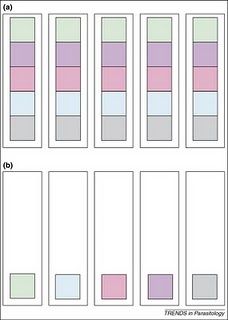Explosive radiation (in) rocks!
 Tuesday, April 6, 2010 at 10:00AM
Tuesday, April 6, 2010 at 10:00AM Much like internal waves, I always loved the idea of explosive radiation. Not the nasty, pernicious Chernobyl kind; I mean the rapid evolution of a whole bunch of species from a common ancestor, over a relatively short period of time. There's a few textbook examples of explosive radiations, but none so well-worn (possibly even hackneyed) as that of the cichlid fishes in the rift lakes of eastern Africa. The startling diversity of these little fishes in lakes Tanganyika, Malawi and Victoria has kept evolutionary biologists busy (and Africans fed) for years. See for example, the paper by Elmer and colleagues cited below, which points out that due to the drying-out of Lake Victoria 15-18,000 years ago, either all the cichlids there evolved since then based on stock that re-colonised from Lake Tanganyika, or they sought refuge elsewhere during the dry spell and returned when the lake refilled.
Cichlids are nice and all, but if you look around, you start to see radiations all over the place. Turtles, bivalves and salamanders in the US south-east; tetras in the Amazon, eleotrid gudgeons in Australia, and gobies on coral reefs are just a handful of aquatic examples that are still with us, but there are many others in the fossil record too (hence my title) including trilobites and ammonoids and lots more. Presumably these are the sorts of patterns that led Stephen Jay Gould and Niles Eldredge to develop the concept of punctuated equilibrium back in the 70's: theirs was the idea that evolution proceeds not gradually, but in fits and starts, in response to dramatic environmental changes and chance events. The way I see this idea, most of the species we observe around us are the dregs of explosive radiations past, whittled away by extinctions to just the most successful few, either gradually or equally punctuated. Cases like the rift-lake cichlids are just ones in which relatively few have gone extinct yet (but see the effects of the introduced Nile perch!)
All of this was just a preamble for what I really wanted to post about, which was about a radiation I only heard about recently. Late last year I was at a scientific exchange of US and Russian fish health researchers organised by the National Fish Health Research Laboratories and sponsored by the Living Oceans Foundation, at which one of the Russian speakers Maxim Timofeev introduced us the radiation of several groups, including amphipods, in Russia. Amphipods are (usually) tiny shrimp-like animals that live on the bottom or among dense plants or algae; read more about them in the Väinölä paper cited below. Well, in Siberia's Lake Baikal, the worlds oldest, largest and deepest freshwater lake, they underwent a remarkable radiation, to produce over 300 species (a third of the worlds entire fauna), including spectacular beasts such as the fish predator (!) shown here. I mean, HOW AWESOME IS THAT THING? Freaks me almost as much as giant wetas used to do, when I was younger (if you don't dig on bugs, I recommend not clicking that link...). Anyway, I had no idea these things existed until Maxim gave his talk. Don't you just love discovering new critters you never knew about before? And not just one, but hundreds.(Check out this link about Baikal fauna too; the language is just terrific. Try this turn of phrase on for size: "When it comes to tenderness and gustatory qualities of meat, the omul knows no rivals")
Elmer, K., Reggio, C., Wirth, T., Verheyen, E., Salzburger, W., & Meyer, A. (2009). Pleistocene desiccation in East Africa bottlenecked but did not extirpate the adaptive radiation of Lake Victoria haplochromine cichlid fishes Proceedings of the National Academy of Sciences, 106 (32), 13404-13409 DOI: 10.1073/pnas.0902299106
Väinölä, R., Witt, J., Grabowski, M., Bradbury, J., Jazdzewski, K., & Sket, B. (2007). Global diversity of amphipods (Amphipoda; Crustacea) in freshwater Hydrobiologia, 595 (1), 241-255 DOI: 10.1007/s10750-007-9020-6
 2 Comments |
2 Comments |  Email Article | tagged
Email Article | tagged  NFHRL,
NFHRL,  diversity,
diversity,  fish,
fish,  invertebrate,
invertebrate,  lake baikal,
lake baikal,  russia,
russia,  siberia,
siberia,  taxonomy
taxonomy 







